Giulio Tononi
Dissociating Artificial Intelligence from Artificial Consciousness
Dec 05, 2024Abstract:Developments in machine learning and computing power suggest that artificial general intelligence is within reach. This raises the question of artificial consciousness: if a computer were to be functionally equivalent to a human, being able to do all we do, would it experience sights, sounds, and thoughts, as we do when we are conscious? Answering this question in a principled manner can only be done on the basis of a theory of consciousness that is grounded in phenomenology and that states the necessary and sufficient conditions for any system, evolved or engineered, to support subjective experience. Here we employ Integrated Information Theory (IIT), which provides principled tools to determine whether a system is conscious, to what degree, and the content of its experience. We consider pairs of systems constituted of simple Boolean units, one of which -- a basic stored-program computer -- simulates the other with full functional equivalence. By applying the principles of IIT, we demonstrate that (i) two systems can be functionally equivalent without being phenomenally equivalent, and (ii) that this conclusion is not dependent on the simulated system's function. We further demonstrate that, according to IIT, it is possible for a digital computer to simulate our behavior, possibly even by simulating the neurons in our brain, without replicating our experience. This contrasts sharply with computational functionalism, the thesis that performing computations of the right kind is necessary and sufficient for consciousness.
What we are is more than what we do
Jan 21, 2021Abstract:If we take the subjective character of consciousness seriously, consciousness becomes a matter of "being" rather than "doing". Because "doing" can be dissociated from "being", functional criteria alone are insufficient to decide whether a system possesses the necessary requirements for being a physical substrate of consciousness. The dissociation between "being" and "doing" is most salient in artificial general intelligence, which may soon replicate any human capacity: computers can perform complex functions (in the limit resembling human behavior) in the absence of consciousness. Complex behavior becomes meaningless if it is not performed by a conscious being.
A macro agent and its actions
Mar 31, 2020
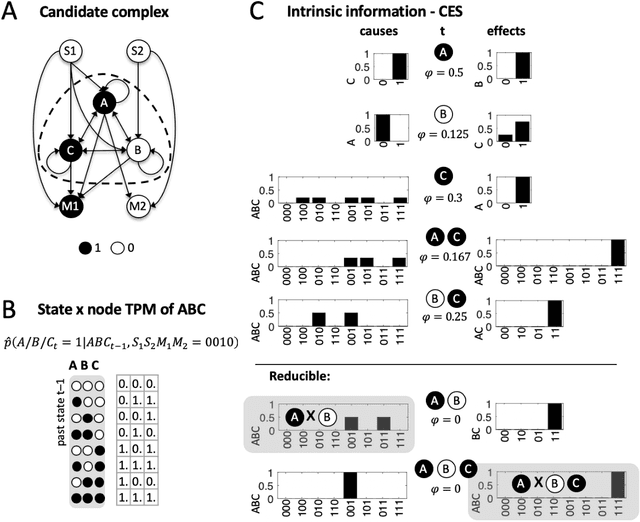
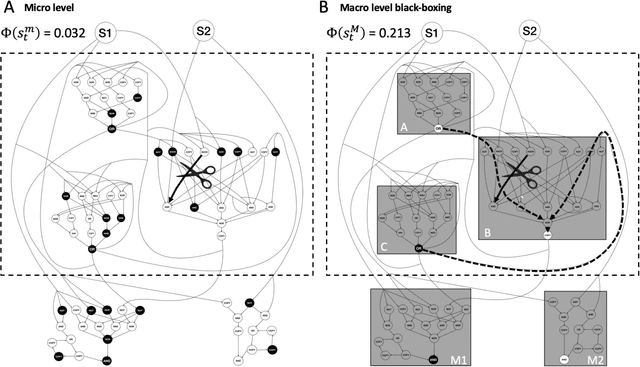

Abstract:In science, macro level descriptions of the causal interactions within complex, dynamical systems are typically deemed convenient, but ultimately reducible to a complete causal account of the underlying micro constituents. Yet, such a reductionist perspective is hard to square with several issues related to autonomy and agency: (1) agents require (causal) borders that separate them from the environment, (2) at least in a biological context, agents are associated with macroscopic systems, and (3) agents are supposed to act upon their environment. Integrated information theory (IIT) (Oizumi et al., 2014) offers a quantitative account of causation based on a set of causal principles, including notions such as causal specificity, composition, and irreducibility, that challenges the reductionist perspective in multiple ways. First, the IIT formalism provides a complete account of a system's causal structure, including irreducible higher-order mechanisms constituted of multiple system elements. Second, a system's amount of integrated information ($\Phi$) measures the causal constraints a system exerts onto itself and can peak at a macro level of description (Hoel et al., 2016; Marshall et al., 2018). Finally, the causal principles of IIT can also be employed to identify and quantify the actual causes of events ("what caused what"), such as an agent's actions (Albantakis et al., 2019). Here, we demonstrate this framework by example of a simulated agent, equipped with a small neural network, that forms a maximum of $\Phi$ at a macro scale.
PyPhi: A toolbox for integrated information theory
Jun 27, 2018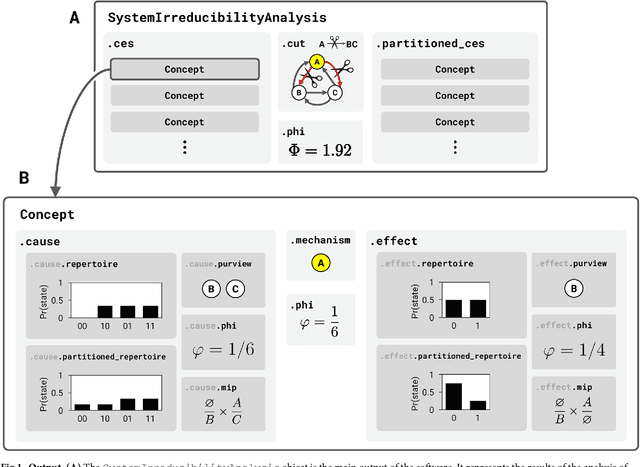
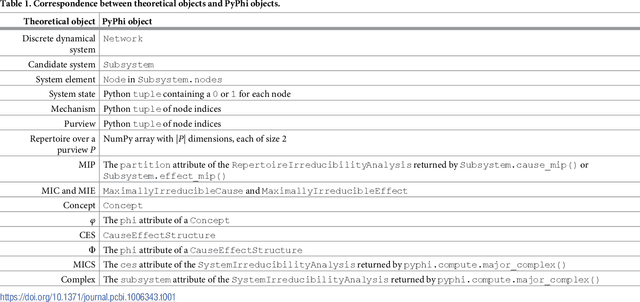
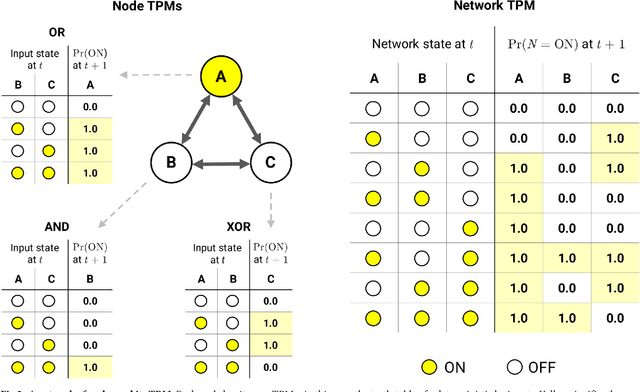
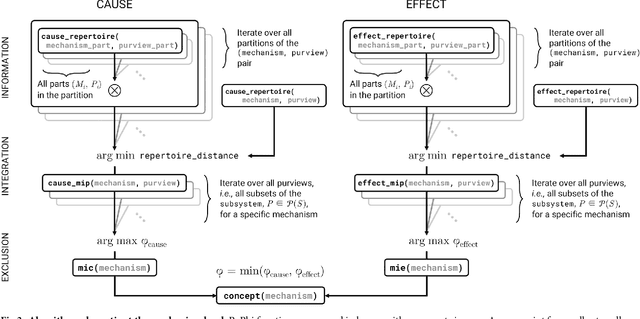
Abstract:Integrated information theory provides a mathematical framework to fully characterize the cause-effect structure of a physical system. Here, we introduce PyPhi, a Python software package that implements this framework for causal analysis and unfolds the full cause-effect structure of discrete dynamical systems of binary elements. The software allows users to easily study these structures, serves as an up-to-date reference implementation of the formalisms of integrated information theory, and has been applied in research on complexity, emergence, and certain biological questions. We first provide an overview of the main algorithm and demonstrate PyPhi's functionality in the course of analyzing an example system, and then describe details of the algorithm's design and implementation. PyPhi can be installed with Python's package manager via the command 'pip install pyphi' on Linux and macOS systems equipped with Python 3.4 or higher. PyPhi is open-source and licensed under the GPLv3; the source code is hosted on GitHub at https://github.com/wmayner/pyphi . Comprehensive and continually-updated documentation is available at https://pyphi.readthedocs.io/ . The pyphi-users mailing list can be joined at https://groups.google.com/forum/#!forum/pyphi-users . A web-based graphical interface to the software is available at http://integratedinformationtheory.org/calculate.html .
* 22 pages, 4 figures, 6 pages of appendices. Supporting information "S1 Calculating Phi" can be found in the ancillary files
What caused what? An irreducible account of actual causation
Aug 22, 2017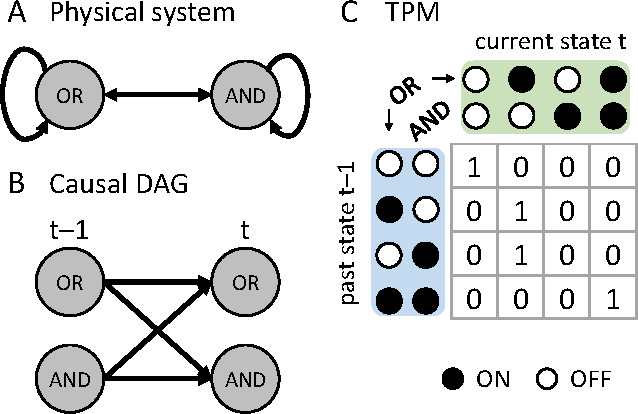

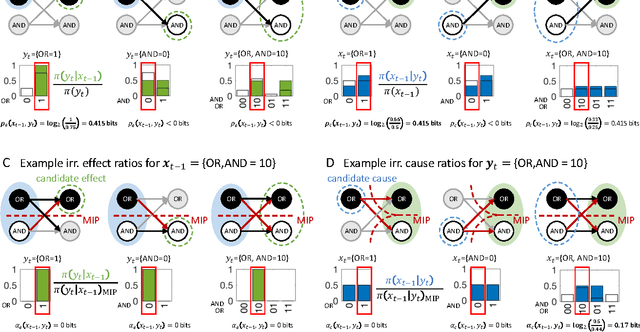
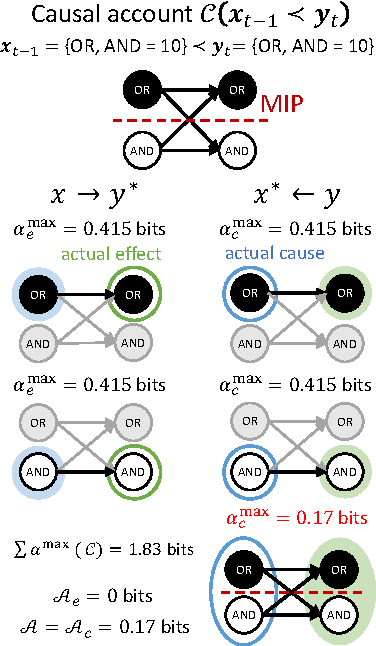
Abstract:Actual causation is concerned with the question "what caused what?". Consider a transition between two subsequent observations within a system of elements. Even under perfect knowledge of the system, a straightforward answer to this question may not be available. Counterfactual accounts of actual causation based on graphical models, paired with system interventions, have demonstrated initial success in addressing specific problem cases. We present a formal account of actual causation, applicable to discrete dynamical systems of interacting elements, that considers all counterfactual states of a state transition from t-1 to t. Within such a transition, causal links are considered from two complementary points of view: we can ask if any occurrence at time t has an actual cause at t-1, but also if any occurrence at time t-1 has an actual effect at t. We address the problem of identifying such actual causes and actual effects in a principled manner by starting from a set of basic requirements for causation (existence, composition, information, integration, and exclusion). We present a formal framework to implement these requirements based on system manipulations and partitions. This framework is used to provide a complete causal account of the transition by identifying and quantifying the strength of all actual causes and effects linking two occurrences. Finally, we examine several exemplary cases and paradoxes of causation and show that they can be illuminated by the proposed framework for quantifying actual causation.
Integrated information increases with fitness in the evolution of animats
Oct 03, 2011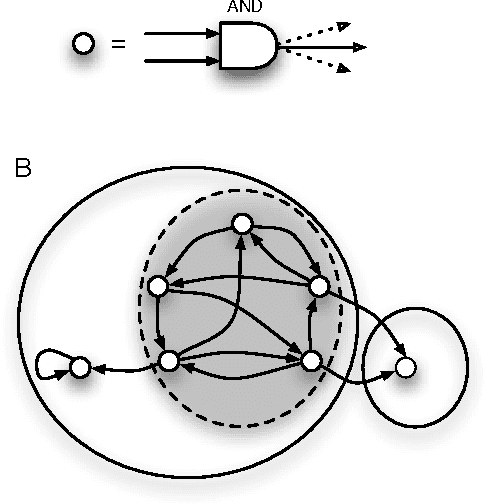

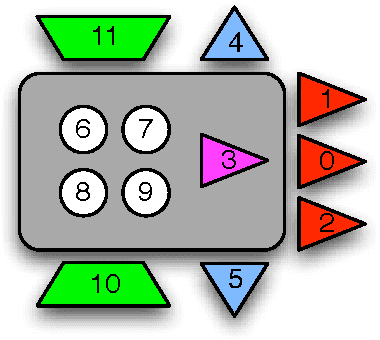
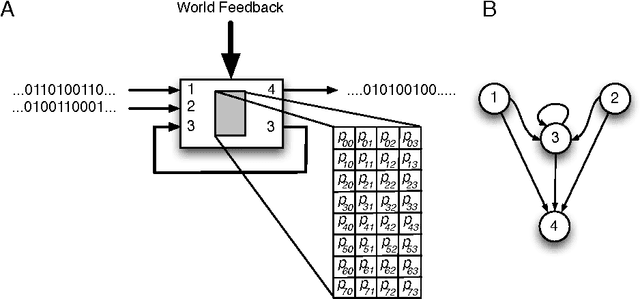
Abstract:One of the hallmarks of biological organisms is their ability to integrate disparate information sources to optimize their behavior in complex environments. How this capability can be quantified and related to the functional complexity of an organism remains a challenging problem, in particular since organismal functional complexity is not well-defined. We present here several candidate measures that quantify information and integration, and study their dependence on fitness as an artificial agent ("animat") evolves over thousands of generations to solve a navigation task in a simple, simulated environment. We compare the ability of these measures to predict high fitness with more conventional information-theoretic processing measures. As the animat adapts by increasing its "fit" to the world, information integration and processing increase commensurately along the evolutionary line of descent. We suggest that the correlation of fitness with information integration and with processing measures implies that high fitness requires both information processing as well as integration, but that information integration may be a better measure when the task requires memory. A correlation of measures of information integration (but also information processing) and fitness strongly suggests that these measures reflect the functional complexity of the animat, and that such measures can be used to quantify functional complexity even in the absence of fitness data.
* 27 pages, 8 figures, one supplementary figure. Three supplementary video files available on request. Version commensurate with published text in PLoS Comput. Biol
 Add to Chrome
Add to Chrome Add to Firefox
Add to Firefox Add to Edge
Add to Edge